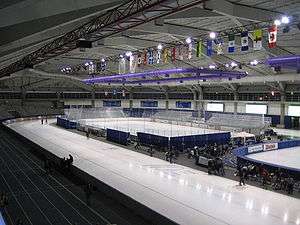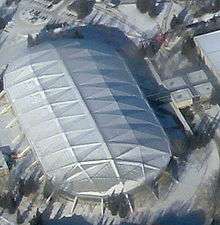Olympic Oval
 | |
| Location |
2500 University Drive NW Calgary, Alberta |
|---|---|
| Owner | University of Calgary |
| Operator | University of Calgary, Faculty of Kinesiology |
| Capacity | 2,000: (4,000 with temporary seating)[1] |
| Construction | |
| Broke ground | 1985 |
| Opened | September, 1987 |
| Architect | Graham - McCourt |
| Tenants | |
| National Speed Skating Team, National Speed Skating Development Team, Oval Program, University of Calgary Dinos Hockey | |
The Olympic Oval in Calgary, Alberta, Canada, is a covered speed skating oval built for the 1988 Winter Olympics.[2] It is the official designated training center for Speed Skate Canada and the Canadian National Speed Skating team. It is located on the University of Calgary campus. Thanks to two propane Zamboni ice resurfacers, the high altitude (1,105 m), and the advanced climate control, the oval is known as "The fastest ice on Earth".[3] In 2012, the Olympic Oval commemorated its 25th year of public service with a number of exciting activities and celebrations.
History
The Olympic Oval was designed as the first covered speed skating oval in North America, and as the first to be used at Winter Olympics. Being domed, this would give the facility the ability to control climate conditions inside to produce the highest quality ice possible.
Construction of The Oval began in 1985, nearly four years after Calgary had been designated host of the XV Olympic Winter Games. Like the Olympic Saddledome most of the Oval's structure was built using precast, prestressed concrete. 28 beams were laid along the outside of the perimeter of the building to support 84 additional beams used to construct a lattice frame for the arched roof. The interior scaffolding used to hoist these 84 beams had to be lowered a centimetre at a time in a predetermined sequence in order to distribute the load of the roof equally to each of the 28 exterior support beams. Construction was completed by the end of the summer of 1987, officially opening in September 1987, five months before the beginning of the Olympics.

It was during the speed skating events of the Olympic Winter Games in 1988 that The Oval became known as "the fastest ice on Earth", as world records times were set in seven distance events (Men's 500 m, Men's 1500 m, Men's 10000 m, Women's 500 m, Women's 1000 m, Women's 3000 m and Women's 5000 m), and new Olympic records were set in the other three events (Men's 1500 m, Men's 5000 m and Women's 1500 m).
The combination of the climate-controlled facility and the effects of high altitude have been credited for the fast ice surface. Throughout the following 14 years the vast majority of speed skating world records were set at The Oval. The Olympic Oval has now been re-nicknamed The fastest ice in the world, holding 12 current world records. The Oval continues to be regarded as a premier speed skating venue, and a preferred training facility for speed skating teams across the globe.
Along with the 400 m long-track speed skating oval the Olympic Oval also includes two international-sized ice rinks for short-track speed skating and ice hockey, as well as a 450 m running track surrounding the main oval and an eight-lane 110 m sprint track for year-round athletics training.
When not hosting hockey games and speed skating competitions, The Oval is open to public skating, family day events and the Calgary Science Fair.

References
- ↑ "Calgary Olympic Oval Self Guided Tour: Panel 4 - The Building". Ice Speed Skating Ovals and Clubs in Canada. Retrieved October 20, 2012.
- ↑ 1988 Winter Olympics official report. Part 1. pp. 144-51.
- ↑ "Building on the Olympic Legacy". Calgary Herald. 2013-02-09. pp. A15–A16.
External links
- The Olympic Oval at University of Calgary
- XVth Olympic Winter Games - Venues to Match the Events
- Calgary Speed Skating Association - CSSA
Coordinates: 51°04′37″N 114°08′08″W / 51.07694°N 114.13556°W
